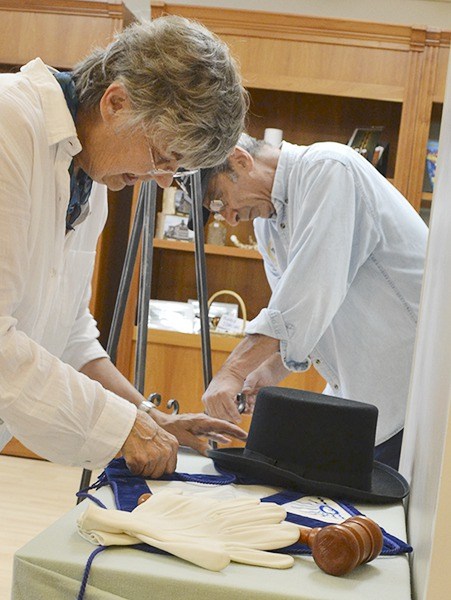100 years of Sequim Freemasons
• On exhibit:
“Sequim Masonic Lodge Celebrates 100 years”
Display starts Aug. 7, with the First Friday Art Walk
and runs through September.
• Get the book:
“Freemasons in the Sequim-Dungeness Area: 1915-2015”
Available at the Sequim Museum & Arts Center, 175 W. Cedar St.
Cost: $20
Author John Majors will be at the museum for signings during the art walk
Take orders for the book if more are needed.
Masons also featured in a cancelation stamp at the Strait Stamp Show in the lodge on Aug. 8.
You probably know the names of many of the families that helped shape Sequim. There are the Bekkevars, the Cays, the Clarks, the Lotzgesells and so many more.
But as historian John Majors discovered, many of these shakers and movers in the community have one thing in common — they also make up the Sequim Masonic Family of Lodge No. 213.
This year marks the centennial for the Sequim Freemasons after the 20 founding members received permission to form a lodge in Nov. 9, 1915.
To celebrate, Majors, with help from his wife Beverly and volunteers with the Sequim Museum & Arts Center and Masonic Lodge, authored a new book “Freemasons in the Sequim-Dungeness Area: 1915-2015.”
It covers the history of the lodge and all 96 of its Worshipful Masters who are elected dignitaries that maintain operations, memorize hours of ceremonies and lead the group.
The lodge also sponsors a two-month exhibit at the Sequim Museum & Arts Center on Cedar Street starting on Aug. 7 with the First Friday Art Walk.
Nine months of research
What started as a plan for a simple PowerPoint presentation ballooned into a full-on research project, Majors, the lodge’s 2007 Worshipful Master, said.
“I was going to print the pictures of the Masters of the last 100 years and be done with it,” he said.
But as he delved more into the lodge’s members’ rich history, “it went on to one month and two and more and I told the lodge to forget (the presentation),” he said. “We’ve got to do it right. It’s too important of a thing to let it go down in history (without documenting it).”
Nine months later, the book was complete and Majors said many of the original and early members’ descendants were able to proof the biographies.
In 100 years, Sequim’s lodge has hosted nearly 700 members, Majors said, so for the book he had to narrow his biographies down to mostly the Worshipful Masters with a few other instrumental members.
Majors and his wife researched obituaries and family files from the museum and the lodge’s archives to find any information available.
“(Worshipful Masters) are elected every year,” Majors said. “Some of the 96 were elected in back-to-back years or some came back like (Richard H. “Dick” Bekkevar (2002) who was followed by his son (James R. “Jim” Bekkevar one year (2003).”
The Bekkevars, for example, were one of the families to have a family file at the museum.
Digging for so many people’s biographies was a lot of work, Majors said, but he hopes existing and future Masons learn the history behind their lodge and its leaders.
“The members of this lodge helped create this town,” he said.
With the museum exhibit, Beverly Majors said she took a broader approach featuring all 96 Worshipful Masters’ photos with the year(s) they served, a blurb about their time in Sequim and some historical photographs and artifacts centered on Masonry.
Some of the artifacts include an original document from original Worshipful Master Charles F. Seal when he became the Master of the lodge, former Worshipful Master Marvin L. Conn’s lambskin apron awarded to Masters upon election (1994) and more.
Beverly said Conn’s item is a rarity because many former Masters are often buried with their aprons.
Origins
Sequim’s Masonic Lodge has featured an array of people and leaders including scientists, a stuntman, educators, politicians, businessmen, a veterinarian and more.
The idea of forming a Dungeness lodge was first discussed in 1906 with Port Angeles Lodge No. 69, Majors notes, but nothing happened until nine years later with the Sequim Lodge forming.
At first, meetings were held in the second story of the Sequim Tire Shop/Gas Station until the club built its first lodge in 1931 on the southwest corner of Sequim Avenue and Alder Street on land donated by Seal. Its current lodge was built in 1987 at 700 S. Fifth Ave. on land donated by John F. Kirner (1958 Master).
The Masons also have several other groups that fall under its umbrella, including the Shriners, the Order of the Eastern Star for women, DeMolay International for boys, the Scottish Rite and the International Order of the Rainbow for Girls.
They also are active in the community as an organization by providing annual college scholarships for Sequim seniors and have awarded nearly $900,000 to about 600 students since 1977.
Masons also support numerous local nonprofits and provide free health screenings and identification for children.
While Freemasonry remains one of the oldest fraternal societies with private meetings and secret handshakes and words, Majors said to be a member, you just have to ask.
“(Members) are supposed to lead upon example with good works and such and impress upon other people with those good deeds where they ask, “How do I become a member of this ancient, honorable institution,” Majors said.
The lodge hosts a public coffee chat every Thursday at 10 a.m.
For more information on the Sequim Masonic Lodge No. 213, visit www.bluelodge-wa.org/sequim213.
For more information about the museum exhibit, visit www.macsequim.org.



